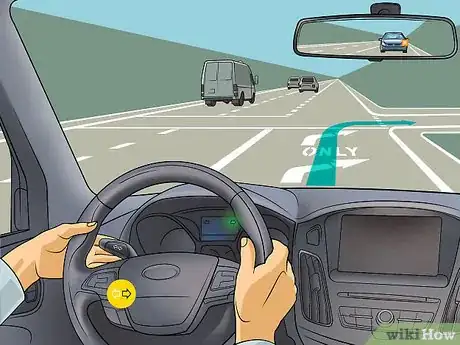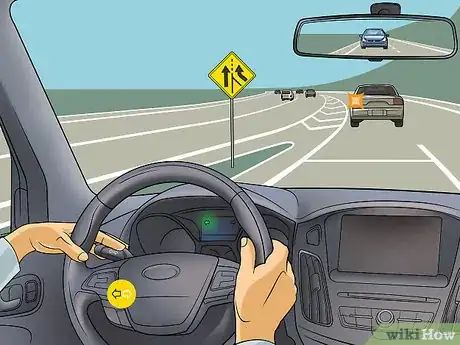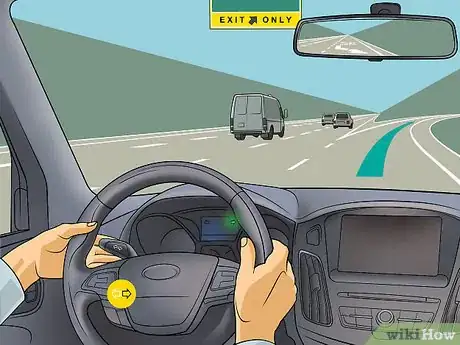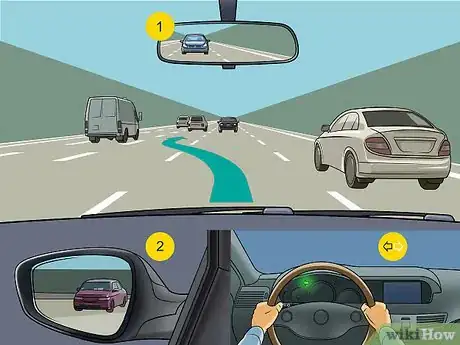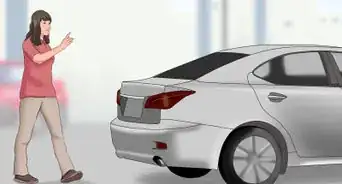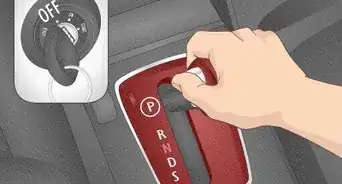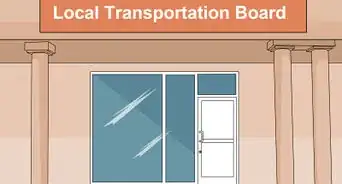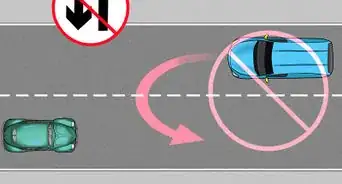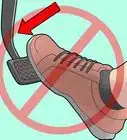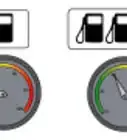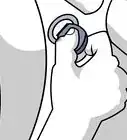This article was co-authored by Ibrahim Onerli. Ibrahim Onerli is a Driving Instructor and the Manager of Revolution Driving School in New York City. His mission is to make the world a better place by teaching safe driving. Ibrahim trains and manages a team of over eight driving instructors. He specializes in teaching defensive driving and stick shift driving.
There are 7 references cited in this article, which can be found at the bottom of the page.
wikiHow marks an article as reader-approved once it receives enough positive feedback. In this case, 93% of readers who voted found the article helpful, earning it our reader-approved status.
This article has been viewed 670,058 times.
Part of safe driving is letting other drivers around you know what you intend to do. Using your turn signals is not difficult, and it's generally required by law whenever you make a turn or change lanes. By providing a signal, you communicate to others on the road. This keeps you and other drivers safe and prevents accidents.
Steps
Using Turn Signals to Make a Turn
-
1Locate the lever on the left side of the steering column.[1] The turn signal is a long lever, usually black or gray in color. When moved up or down, this lever will cause a light on either the left or right side of your car to flash.
Note: The turn signal will not make a sound or light the signal light on your car unless the car is running.
-
2Use the turn signal to indicate a turn to the left. To signal a left turn, wait until you are approximately 30 yards from the corner around which you intend to turn.[2] Ensure you are in the left-turn lane, then push the turn signal lever down gently with your left hand. When the turn signal locks in place, you’ll be able to see a flashing arrow directed to the left on your instrument cluster. You’ll also hear a tick-tock sound which clicks in time with the flashing of the light. This indicates that the signal is operating properly. Return your hand to the steering wheel and continue driving.
- Keep your right hand on the wheel while flicking the signal lever down with your left hand.
- Turn on the signal before braking to let other drivers know why you are slowing.
EXPERT TIPIbrahim Onerli is a Driving Instructor and the Manager of Revolution Driving School in New York City. His mission is to make the world a better place by teaching safe driving. Ibrahim trains and manages a team of over eight driving instructors. He specializes in teaching defensive driving and stick shift driving.Driving Instructor
 Ibrahim Onerli
Ibrahim Onerli
Driving InstructorGive other drivers plenty of notice before your turn. By law, you need to start signaling about 100 feet in advance of your turn, but it's best if you start signaling about a half a block before you plan to switch a lane or make a turn.
Advertisement -
3Indicate a right-hand turn with the turn signal.[3] To signal a right turn, wait until you are within about 30 yards of the corner you wish to round. Ensure you are in the right-turn lane, then move the lever up with your left hand. The series of events which follow are similar to those which occur when making a signal to turn towards the left.
Note: Once you have moved the lever up, an arrow light will begin blinking on the dashboard instrument cluster. You will also hear a metronome-like sound at regular intervals which clicks in time with the flashing light on your instrument cluster.
-
4Ensure your turn signal turns off after your turn has been completed. Normally, the signal will automatically turn off after you have completed the turn, but if the turn was less than 90 degrees, the signal may not turn off. Check the indicator panel above and just behind your steering wheel. Listen for the rhythmic tick-tock sound of the signal blinking on and off.[4]
- If you see the indicator light blinking or hear the signal sound, reach over to the signal lever with your left hand and gently move it to the “off” position.
- Failing to turn your turn signal off after you have completed a turn can be illegal and cause confusion for other drivers.
-
5Signal your turn even if you are in a turning lane. Some traffic lanes are reserved for left or right turns only. While it might seem unnecessary to indicate you’re turning when it should be obvious based on the lane you’re in, use the turn signal anyway. Drivers who are not familiar with the area or who cannot see the signs due to multiple vehicles ahead of them in the lane will appreciate the indication as to where you are headed, and could clue them into the fact that your lane is for turning in a given direction.
Plus, the law requires that you make a turn with your turn signal.
-
6Don’t turn your turn signal on too soon. Only activate your turn signal when there are no intervening streets or alleys between you and the place you wish to turn. If you turn your signal on too soon, someone might think you are turning into a parking lot or down a street which you actually are not.[5]
- This confusion could lead to an accident or to you being cut off.
Using Turn Signals to Merge Into or Out of Traffic
-
1Use your turn signal when pulling out from the curb.[6] Before leaving a parking spot on the side of the street, it is important to indicate you’re about to merge into traffic. After getting in your car, activate your turn signal in the direction you wish to merge. For instance, if you are parked on the right side of the street and you wish to merge into the lane parallel to your vehicle on the left side, activate your left-hand turn signal by pulling down on the signal lever.
- Check your side mirror to ensure there is space in the flow of traffic to pull out, then turn your wheel hard to the left and accelerate gently.
- Return the signal lever to the neutral (starting) position by pushing up gently on it.
-
2Get on a highway with your turn signal. When merging onto the highway, accelerate quickly so that you attain the speed appropriate for highway driving. About halfway down the on-ramp, flick your left-hand turn signal on. This will demonstrate that you want to get over, but remember, you do not have the right-of-way when merging. Be careful when merging into high-speed traffic.
- While some highways are constructed in such a way that there is no other option but to merge, some on-ramps turn into independent lanes which connect to the next exit if it is nearby. In either case, using your turn signal will alert other highway drivers to your desire to merge, and will give them time to slow down or change lanes in order to let you do so.
- Look out your left-side window when merging into highway traffic, that way, you can see where cars are relative to you, and will be able to time your merge better. Check your rear-view mirror and left side mirror as you merge in order to identify a gap in the flow of traffic.
- Once you’ve found your gap, merge quickly to the left. Spend no more than 2-3 seconds moving from the on-ramp to the highway proper.
-
3Exit the highway with your turn signal. Position yourself in the far-right lane on the highway; if your exit ramp is on the left, position yourself in the far-left lane of the highway. Turn the appropriate turn signal on when you’re about 100 yards from the off-ramp. Do not slow down as you approach the off-ramp. Once you’ve hit the off-ramp, adjust your turn signal lever to indicate your next move: Only modify your speed and adjust your turn-signal once you are on the off-ramp.
- If you’re going straight, place it in the neutral position.
- If you’re turning left, press the lever down.
- If turning right, keep your signal on in the right-hand turn position all the way to the end of the off-ramp.
-
4Indicate when you wish to change lanes with your turn signal. If, for instance, you are in the right lane and want to change to the left lane, you can do easily and safely by employing your turn signal.
- First, put your turn signal on in the direction you wish to go. To move into the right lane, push your turn signal up to let others know you wish to move to the right. To move into the left lane, push your turn signal lever down to indicate that you wish to move into the left lane.
- Activate the turn signal at least five seconds before you wish to change lanes.[7]
- Don’t switch the signal on for just one or two flickers. Place it in the locked position just as you would when making a turn.
- If all is clear, turn your wheel slightly toward the lane you wish to merge into. Once you’re completely within the boundaries of the lane, move your left hand to your turn signal lever and switch it off.
- Do not cross multiple lanes of traffic with a single activation of your turn signal. If you know you need to cross many lanes, give yourself the adequate time and space to do so. Plan your lane merges ahead of time.
Community Q&A
-
QuestionHow can I switch the turn signal off?
 Community AnswerSimply push the signal lever into the neutral position. The neutral position is located between the left and right turn signal positions, and is the default signal lever position on a car.
Community AnswerSimply push the signal lever into the neutral position. The neutral position is located between the left and right turn signal positions, and is the default signal lever position on a car. -
QuestionWhen turning out of a parking lot, do I have to use my turn signal?
 Community AnswerYes. It is always good practice to use your blinker. It keeps you safe and it lets those around you know where you're going.
Community AnswerYes. It is always good practice to use your blinker. It keeps you safe and it lets those around you know where you're going. -
QuestionWhen passing another vehicle, do I need to use my turn signals?
 Community AnswerYes, you must use your turn signals when moving into and out of any lane. This is true whether passing on a highway or overtaking another car on a regular road.
Community AnswerYes, you must use your turn signals when moving into and out of any lane. This is true whether passing on a highway or overtaking another car on a regular road.
Warnings
- Always look where you are going and do not turn unless it is safe to do so.⧼thumbs_response⧽
- When signaling, make sure at least one hand is on the wheel at all times.⧼thumbs_response⧽
References
- ↑ http://www.ocregister.com/articles/turn-372844-signal-signals.html
- ↑ https://www.dmv.ca.gov/portal/dmv/detail/pubs/hdbk/signaling
- ↑ http://www.dmv.state.va.us/webdoc/pdf/dmv39.pdf
- ↑ http://www.huffingtonpost.ca/andrew-tai-/turn-signals_b_6211352.html
- ↑ https://www.dmv.ca.gov/portal/dmv/detail/video/lets_drive/rules/Signaling_and_Merging
- ↑ https://www.dmv.ca.gov/portal/dmv/detail/video/lets_drive/rules/Signaling_and_Merging
- ↑ https://www.dmv.ca.gov/portal/dmv/detail/pubs/hdbk/signaling
- ↑ https://www.dmv.ca.gov/portal/dmv/?1dmy&urile=wcm:path:/dmv_content_en/dmv/pubs/dl603/teen_htm/drivingskills
About This Article
To properly use your turn signal while you’re driving, first locate the lever on the left side of your steering column. You should find this before you start driving your vehicle. Push the lever down gently to signal that you are preparing to make a left-hand turn, and push up on the lever to signal a right-hand turn. You can also use these signals to indicate that you are planning to change or merge lanes. For tips on safely merging with traffic, keep reading!




